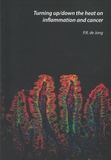Turning up/down the heat on inflammation and cancer
Summary
Homeostasis in mammalian tissues is achieved by the complex orchestration of activatory and inhibitory signals. These signals control the balanced turnover and functional properties of epithelial and immune cells which ensures protection of host cells against exogenous and endogenous dangers. Part of this balancing act are signaling pathways that can be activated rapidly and transiently (such as in systemic inflammation) or constitutively on the background (such as anti-proliferative pathways in the gut). We investigated the anti-inflammatory response in the sterile circulation in the context of systemic inflammation caused by open heart surgery. We established that post-operative patient plasma represents an immunosuppressive environment for monocytes. This was mediated by an interleukin (IL)-10/STAT3 signaling axis and disappeared after the first post-operative day. Thus, on pump cardiac surgery induced a rapid but transient immunoregulatory response. This response was found to be independent of the administration of corticosteroids, which argues against the use of these drugs for this type of surgery given their wide range of adverse effects. In contrast to the circulation, the intestinal tract bears a heavy microbial load. Thus, the mucosal immune system of the gut is generally tolerant to microbial immunostimulants. Nevertheless, a breach of the gut barrier imposes a major challenge to the intestinal homeostasis. We found that neuronal fibers in the intestinal wall that express transient receptor potential, melastatin 8 (TRPM8) promptly released calcitonin gene related peptide (CGRP) upon instigation of acute colitis. This immunoregulatory neuropeptide then inhibited the release of pro-inflammatory cytokines by innate immune cells. In this system, a rapid neuronal feedback loop prevents overactivity by potentially harmful inflammatory cells. Other members of the TRP family also play a role in the regulation of intestinal inflammation. We established that TRP vanilloid 1 (TRPV1) was activated in CD4+ T-cells upon T-cell receptor triggering, and contributed to non-store operated calcium (Ca2+) influx. This TRPV1-mediated Ca2+-influx is required for the full activation and colitogenic properties of CD4+ T-cells. In contrast, the TRP ankyrin 1 (TRPA1) channel counteracts TRPV1 function and thereby mediated anti-inflammatory effects in T-cell mediated colitis. Thus, our work suggested that TRP channel family members can provide either pro- or anti-inflammatory effects in the context of intestinal inflammation. Finally, novel signaling pathways were uncovered in the context of intestinal neoplasia development. We found that TRPV1 is part of a negative feedback loop downstream of the epidermal growth factor receptor (EGFR). This system provides constitutive inhibition of the EGFR to prevent oncogenic transformation of intestinal epithelial cells. On the other hand, we established that abrogation of extracellular signal regulated kinases 1 and 2 (ERK1/2) resulted in prompt activation of ERK5. ERK5 thereby provides a ‘bypass’ route for epithelial cells to maintain cell proliferation, which suggests a novel tumor resistance pathway. Together, our findings demonstrate regulatory pathways that either prevent overactivity of inflammatory signaling pathways (IL-10, CGRP and TRPA1), ensure full activation of immune stimulatory signals (TRPV1 in T-cells), maintain pro-proliferative signals (ERK5), or mediate constitutive negative feedback on growth factor signaling (TRPV1 in the intestine).
